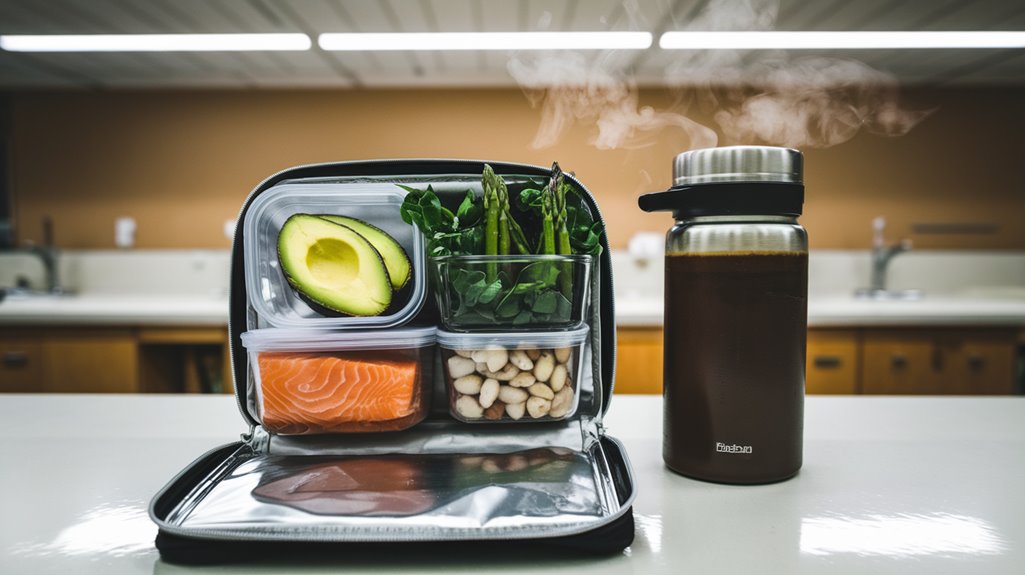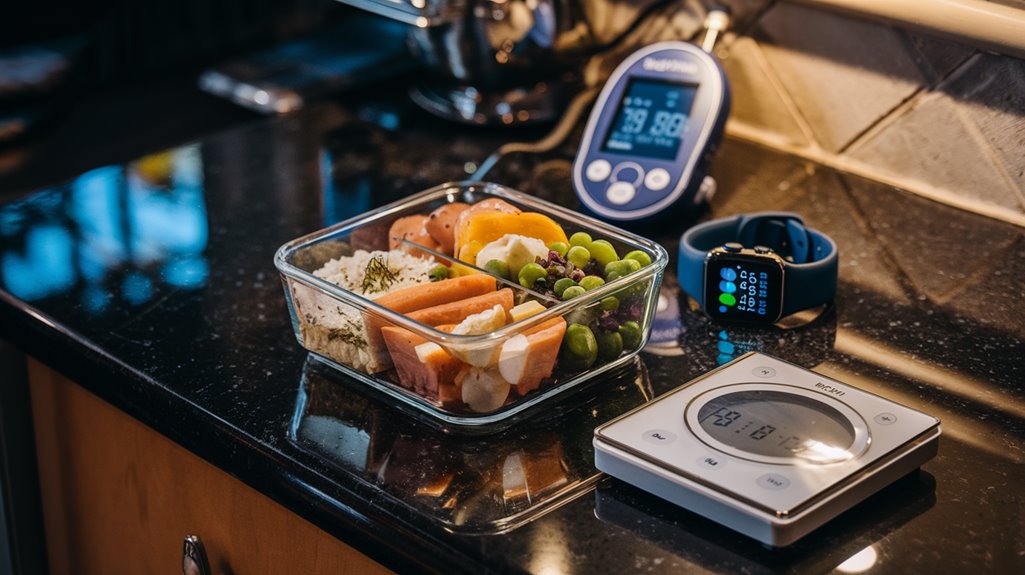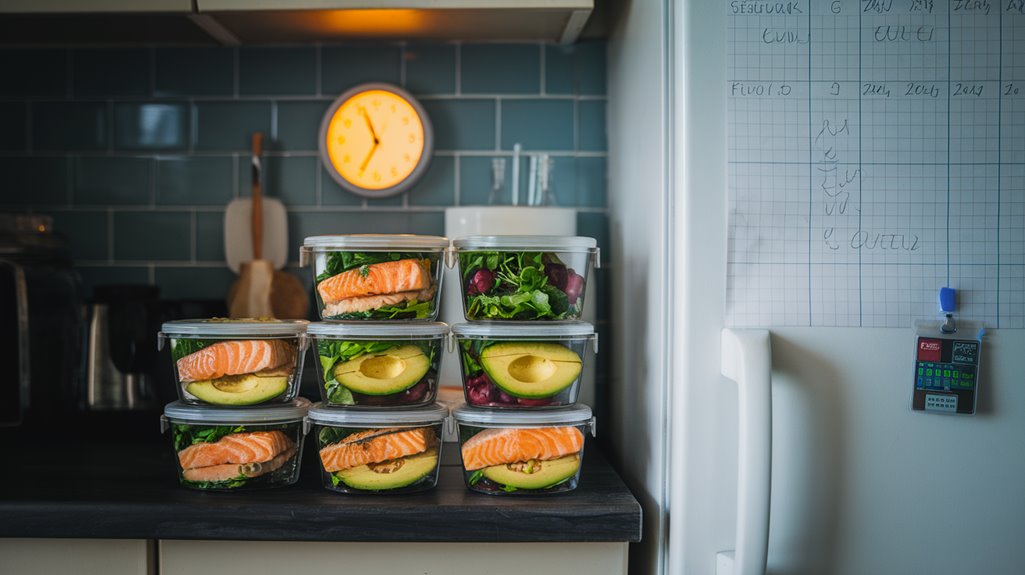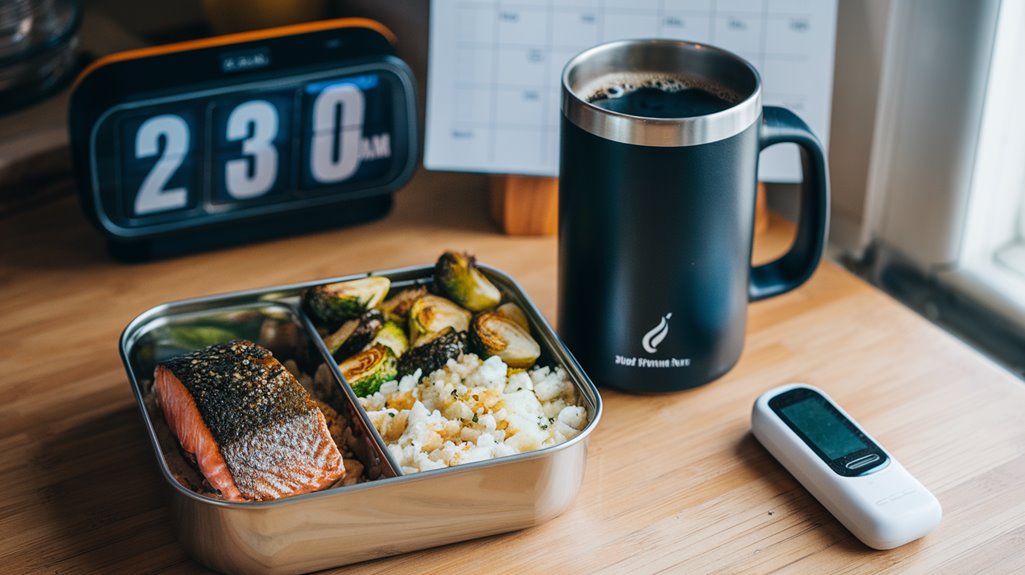You’ll need a specialized keto approach as a night-shift worker due to your disrupted circadian rhythms and 3.57% higher risk of metabolic syndrome. Keto 2.0 allows up to 100g daily carbs while maintaining 70-80% healthy fats, but you should time your meals strategically within 4-6 hour windows during your shift. Focus on nutrient-dense whole foods, maintain electrolyte balance, and track your ketones and glucose. Discover how to optimize your meal timing and snack choices for sustained energy throughout your overnight hours.
Keto Highlights
- Night-shift workers can consume up to 100g carbs daily on Keto 2.0, focusing on whole foods instead of the traditional 20-50g limit.
- Schedule largest meals during daylight, with lighter keto-friendly meals during shifts to support circadian rhythm and prevent digestive issues.
- Aim for 70-80% calories from healthy fats, 20-25% protein, and 5-10% carbohydrates to achieve optimal ketosis during night shifts.
- Pack portable keto snacks like tuna pouches, string cheese, and shelf-stable Moon Cheese to maintain energy throughout shifts.
- Monitor blood glucose, ketones, and sleep patterns while gradually reducing carbs by 10-20g weekly until reaching 50g or less.
Click For Your Best Keto Chocolate– NOW

Understanding the Night-Shift Worker’s Metabolic Challenges
While most people’s bodies follow a natural 24-hour rhythm, night-shift workers face unique metabolic challenges due to disrupted circadian patterns. When you work nights, your central and peripheral body clocks become misaligned, inverting your melatonin and cortisol cycles and dampening glucose tolerance.
Your metabolic health faces significant risks, with research showing night workers have a 3.57% higher incidence of metabolic syndrome. You’ll experience altered insulin sensitivity and glucose regulation, as your body’s AMPK and Nampt/NAD+/Sirt1 feedback mechanisms struggle during fasting periods. Your appetite-regulating hormones, ghrelin and leptin, become dysregulated, leading 81% of night workers to choose high-fat foods after shifts. These hormonal changes, combined with reduced PYY levels, make you more susceptible to unhealthy food cravings despite understanding their negative impact.
The Evolution From Traditional Keto to Keto 2.0
While traditional keto‘s strict macronutrient ratios helped you achieve rapid weight loss through ketosis, Keto 2.0 offers a more sustainable approach by incorporating plant-based fats and allowing up to 100g of daily carbs. You’ll find that replacing saturated animal fats with heart-healthy plant oils and increasing your intake of non-starchy vegetables can better support your night-shift lifestyle. This modern adaptation maintains the fat-burning benefits while providing the additional nutrients and flexibility you need for long-term metabolic health during irregular work hours.
Beyond Strict Macros
As ketogenic science has evolved, the traditional strict approach has given way to a more sustainable variation known as Keto 2.0. This updated protocol allows for up to 100g of net carbs daily, compared to the traditional 20-50g limit, while emphasizing whole, nutrient-dense foods over processed alternatives.
You’ll notice significant adjustments in protein intake, increasing from 20-25% to 30-35% of total calories, supporting muscle maintenance and improved satiety. The integration of intermittent fasting enhances ketone production and metabolic flexibility through various fasting windows like 16/8 or 18/6.
This reformed approach prioritizes food quality over strict macro counting, encouraging a wider variety of fruits and vegetables while limiting artificial sweeteners. You can now implement carb cycling strategies to optimize exercise performance without compromising ketosis benefits.
Plant-Based Meets Ketosis
The evolution from traditional ketogenic protocols to Keto 2.0 has introduced a significant plant-based dimension that addresses previous nutritional gaps. This modified approach shifts macronutrient ratios to accommodate more plant-based foods while maintaining metabolic benefits. You’ll consume 50-60% of calories from healthy fats, 20-30% from protein, and 15-30% from carbohydrates.
Your food choices will center on non-starchy vegetables, leafy greens, and plant-based proteins like tempeh and spirulina. You’ll incorporate healthy fats from avocados, coconut oil, and nuts while emphasizing fermented foods for gut health. This approach provides more fiber and diverse nutrients than traditional keto, potentially improving heart health and reducing inflammation. Though you may not achieve strict ketosis, you’ll benefit from a more sustainable eating pattern that’s rich in probiotics and plant-based nutrients.
Breaking Down the 50-30-20 Macro Split

Traditional dietary macronutrient splits conflict with ketogenic principles, making a 50-30-20 ratio unsuitable for night-shift workers pursuing ketosis. While this conventional split provides 250g of carbohydrates in a 2000-calorie diet, it prevents the metabolic state required for ketosis, which demands drastically reduced carb intake.
- The 50% carbohydrate allocation (250g) promotes blood sugar fluctuations during night shifts, potentially disrupting energy levels and sleep-wake cycles
- Though the 30% protein ratio (150g) supports muscle maintenance and repair, it’s excessive for ketosis, which typically requires moderate protein intake
- The 20% fat allocation (44g) is insufficient for keto adaptation, as ketogenic diets require 70-80% of calories from healthy fats to maintain ideal energy production and hormone regulation
Circadian Rhythm Optimization Through Diet
Beyond macronutrient ratios, understanding how meal timing affects your circadian rhythm becomes paramount for night-shift workers following a ketogenic diet. Your high-fat ketogenic meals can impact circadian gene expression, making strategic meal timing essential for metabolic health.
You’ll need to balance your ketogenic eating pattern with your body’s natural rhythms. Schedule your largest, most nutrient-dense meals during daylight hours when possible, even if it’s before your shift. During night shifts, opt for lighter keto-friendly meals that won’t disrupt your digestive system. Include circadian-supporting foods like tart cherries and nuts, which contain natural melatonin. You’ll also want to maintain a consistent 12-16 hour fasting window to help reset your internal clock and optimize your metabolic function despite your irregular work schedule.
Strategic Meal Timing for Overnight Shifts

Structuring meal timing effectively during overnight shifts becomes critical for maintaining ketosis and metabolic health. Your body’s natural circadian rhythm affects insulin sensitivity and metabolic function, making strategic meal timing essential for keto adaptation during night work.
- Schedule your main keto meal 1-2 hours before your shift starts to establish a strong metabolic foundation and maintain stable blood sugar.
- Space 2-3 small, fat-focused snacks every 3-4 hours during your shift, incorporating electrolyte-rich foods to support hydration.
- Implement a 12-14 hour fasting window during your sleep period to optimize ketone production and metabolic flexibility.
Align your eating schedule with your modified circadian rhythm by front-loading protein intake early in your shift and shifting to lighter, fat-based foods as your shift progresses. This approach helps prevent digestive issues while supporting sustained energy levels.
Essential Foods for the Night-Shift Keto Kitchen
To master your night-shift keto lifestyle, you’ll need to establish a well-stocked kitchen with foods that support quick preparation and sustained energy. Your meal prep should focus on portable options like pre-portioned fatty meats, hard-boiled eggs, and prepared vegetables that can be easily transported to work in leak-proof containers. For emergency situations during your shift, you’ll want shelf-stable keto foods readily available, such as nuts, pork rinds, and sugar-free protein bars that won’t compromise your ketogenic state.
Smart Meal Prep Basics
While maintaining a keto diet during night shifts presents unique challenges, stocking your kitchen with the right foods facilitates efficient meal preparation and adherence to ketogenic macros. Focus on strategic batch cooking of protein staples like rotisserie chicken and ground beef, which you can portion and store for multiple shifts. Pre-chopped vegetables and prepared healthy fats streamline meal assembly during unconventional hours.
- Batch cook proteins: Prepare hard-boiled eggs, ground beef, and chicken in advance, storing them in single-serving containers
- Pre-portion vegetables: Combine pre-chopped greens, spiralized zucchini, and bell peppers in meal-sized containers
- Create sauce stations: Mix keto-friendly dressings and store pre-portioned nuts, seeds, and cheese for quick healthy fat additions
This systematic approach guarantees you’ll maintain ketosis while managing your night shift schedule efficiently.
Portable Keto-Friendly Snacks
Having readily available keto snacks during night shifts proves essential for maintaining steady energy levels and metabolic ketosis. You’ll find ideal nutrition in protein-rich options like tuna pouches (17g protein) and string cheese (8g protein), which provide sustained energy without disrupting ketosis.
Complement these with nutrient-dense vegetables such as celery, cucumber, and bell peppers, which offer minimal carbs while maintaining electrolyte balance. For healthy fats, incorporate macadamia nuts (21g fat) or almonds (14g fat), which help satisfy hunger and support ketone production.
Pre-packaged alternatives like Moon Cheese (10g fat, 11g protein) and Whisps (10g fat, 13g protein) offer convenient options when fresh foods aren’t practical. These shelf-stable snacks maintain your macronutrient ratios while providing the convenience necessary for night shift work.
Emergency Food Solutions
Since emergencies and schedule disruptions can derail your ketogenic lifestyle, maintaining a well-stocked pantry of shelf-stable keto foods becomes crucial for night-shift workers. Focus on nutrient-dense options that provide ideal macronutrient ratios while requiring minimal preparation.
- Prioritize protein sources like canned wild-caught fish, sugar-free jerky, and pemmican, which deliver essential amino acids without refrigeration
- Stock shelf-stable fats including coconut oil, ghee, and MCT powder to maintain ketosis during unexpected schedule changes
- Include electrolyte supplements and sugar-free protein powder to prevent deficiencies and support metabolic adaptation
Supplement your emergency supplies with canned low-carb vegetables, bone broth, and freeze-dried berries to guarantee micronutrient intake remains consistent. These options provide reliable nutrition when fresh food access becomes limited.
Plant-Based Fats: The Keto 2.0 Advantage
As the ketogenic diet evolves, Keto 2.0’s emphasis on plant-based fats offers significant advantages over traditional animal-based fat sources. You’ll find that incorporating plant-based fats can reduce inflammation and improve cardiovascular health while maintaining ketosis during your night shifts.
| Plant Fat Source | Benefits | Usage Tips |
|---|---|---|
| Avocados | Heart health | Add to meals |
| Coconut oil | Brain function | Mix in coffee |
| Nuts & seeds | Blood sugar control | Pre-shift snacks |
To optimize your night shift performance, aim for 50% of your daily calories from plant-based fats. You can achieve this by cooking with avocado oil, adding MCT oil to your beverages, or snacking on macadamia nuts. These fats will provide sustained energy throughout your shift while supporting your body’s natural circadian rhythms.
Preparing for the Transition Period

While shifting to a ketogenic diet during night shifts requires careful planning, you’ll need to focus on four key elements: gradual carbohydrate reduction, electrolyte management, sleep optimization, and strategic meal timing. Successful adaptation depends on systematically decreasing your carbohydrate intake while maintaining proper mineral balance and circadian rhythm alignment.
- Reduce carbohydrates by 10-20g weekly, starting from 100g daily until reaching 50g or less, while monitoring ketone levels
- Supplement with 3-5g sodium, 300-400mg magnesium, and potassium-rich foods to prevent electrolyte imbalances
- Optimize sleep by maintaining a cool environment (60-67°F), using blackout curtains, and limiting blue light exposure
Align your eating window with your shift schedule, consuming larger meals before work and lighter keto-friendly snacks during your shift. Include a 12-16 hour fasting period between shift end and your next meal.
Managing Energy Levels Through Your Shift
You’ll find ideal energy management through strategic meal timing windows of 4-6 hours during your night shift, aligning with your body’s metabolic patterns. For quick energy boosts between meals, you can incorporate keto-friendly snacks like nuts or MCT oil that maintain ketosis while providing sustained fuel. Your targeted eating schedule should account for both the high-fat macronutrient ratios of the keto diet and your shift’s specific demands to prevent energy crashes and maintain metabolic efficiency.
Strategic Meal Timing Windows
Maintaining ideal energy levels during night shifts requires strategic meal timing that aligns with your body’s altered circadian rhythm. On a keto diet, you’ll need to adjust your eating windows to optimize fat metabolism while supporting your unconventional schedule. Schedule your largest, most fat-rich meal before your shift begins, around 7-8 PM, to establish a strong energy foundation.
- Consume your primary meal (40% of daily calories) 2-3 hours before your shift starts, focusing on keto-friendly proteins and fats
- Plan a moderate-sized meal (30% of calories) halfway through your shift, between 1-2 AM, incorporating easy-to-digest fats
- Take a small protein-rich snack (10% of calories) 2-3 hours before sleep, avoiding heavy fats that could disrupt rest
Quick Energy Boost Methods
Since working night shifts disrupts natural circadian rhythms, implementing strategic energy-boosting methods becomes essential for maintaining alertness and productivity on a keto diet.
You’ll find excellent results by combining power napping with strategic physical activity. Schedule 20-30 minute naps in a dark, quiet space using eye masks and earplugs before or during your shift. Complement these rest periods with brief exercise intervals – try climbing stairs or taking brisk walks during breaks to elevate your energy levels.
For immediate alertness boosts, utilize bright light exposure through therapy boxes or desk lamps during your shift. Stay hydrated by consuming 8 glasses of water, and choose keto-friendly protein-rich snacks to maintain sustained energy. When fatigue hits, perform light stretching exercises or yoga movements to reactivate your body and sharpen your mental focus.
Practical Meal Prep Strategies for Night Workers

Effective meal preparation stands as a cornerstone for night-shift workers following a keto diet, particularly when traditional eating schedules are disrupted. Strategic batch cooking during off-days maximizes efficiency while guaranteeing nutritional adherence. By dedicating 2-3 hours to meal prep, you’ll maintain ketosis through pre-portioned, grab-and-go options that align with your unconventional schedule.
- Utilize airtight containers to store pre-cooked proteins like grilled chicken and hard-boiled eggs
- Prepare mason jar salads with high-fat dressings and low-carb vegetables
- Package individual portions of keto-friendly snacks such as nuts, cheese, and pre-cut vegetables
Store your prepared meals in insulated containers to maintain food safety standards during extended shifts. Implement a systematic labeling approach to track macronutrients and guarantee freshness, while keeping backup frozen portions for unexpected schedule changes.
Navigating Workplace Food Challenges
While night-shift workers face unique dietary obstacles, mastering workplace food challenges is essential for keto success. You’ll need to strategically address common scenarios like vending machines, cafeterias, and work events. Stock your workspace with keto-friendly alternatives like nuts, seeds, and jerky, while keeping emergency snacks in your locker or desk.
When utilizing cafeteria services, request nutrition information, customize meals by eliminating high-carb components, and focus on salad bars with high-fat dressings. For work events, eat keto meals beforehand and bring shareable keto dishes to potlucks. Combat workplace pressure by educating interested colleagues about keto benefits, practicing assertive refusal techniques, and maintaining non-food stress relief strategies. Finding a supportive accountability partner among coworkers can greatly enhance your adherence to ketogenic eating patterns.
Monitoring Health Markers and Progress

For night-shift workers following a ketogenic diet, systematic health monitoring becomes essential due to their altered circadian rhythms and metabolic adaptations. Regular assessment of key biomarkers helps track your body’s response to both the diet and irregular work schedule, ensuring ideal health outcomes and metabolic efficiency.
Regular monitoring of health markers proves crucial for keto-following shift workers, as their unique schedule impacts both metabolic function and circadian balance.
- Track daily metrics: blood glucose levels before and after shifts, blood pressure readings, and ketone measurements using reliable blood meters
- Schedule quarterly evaluations: thorough lipid panels, liver function tests, and inflammatory markers to assess metabolic health
- Monitor sleep-related parameters: use wearable devices to track sleep quality, measure cortisol levels periodically, and assess cognitive function through standardized tests
Maintain detailed records of these measurements to identify patterns and make necessary adjustments to your keto protocol as your body adapts to night-shift work.
Sleep Quality Enhancement Through Nutrition
Building upon the framework of health monitoring, proper nutritional strategies can greatly enhance sleep quality for night-shift workers on a ketogenic diet. You’ll need to time your nutrients carefully, consuming your last meal 2-3 hours before your planned sleep period. Focus on keto-friendly, sleep-promoting foods like fatty fish, eggs, and cheese, which provide essential nutrients including tryptophan, vitamin D, and omega-3 fatty acids.
Maintain electrolyte balance by incorporating magnesium-rich foods such as leafy greens and nuts, while monitoring your sodium intake. You’ll want to limit caffeine at least 6 hours before bedtime and avoid alcohol, which can disrupt your REM sleep. Consider adding tart cherries or L-theanine-rich green tea to your pre-sleep routine, as they naturally support your sleep-wake cycle regulation.
Adapting the Plan for Rotating Schedules

You’ll need distinct nutritional approaches for day shifts versus night shifts, with your keto macros requiring the most precision during overnight hours. By strategically cycling your carbohydrate intake between rotation periods, you can maintain metabolic flexibility while adapting to schedule changes. Meal preparation becomes essential during shift changes, as you’ll want pre-portioned, keto-compliant meals ready to support your body’s adjustment to new working hours.
Different Shifts Different Plans
When rotating between different shift schedules, your keto diet plan must adapt to maintain metabolic consistency and circadian alignment. You’ll need to adjust your meal timing and nutrient intake based on your specific shift pattern while keeping your body in ketosis. Focus on protein-rich foods at the start of your shift and incorporate healthy fats for sustained energy throughout your work hours.
- Morning Shift (6am-2pm): Consume your largest keto meal at breakfast, pack protein-dense snacks, and schedule your final meal by 6pm
- Afternoon Shift (2pm-10pm): Start with a substantial late-morning meal, maintain ketosis with fat-adapted snacks, and have your last meal before midnight
- Night Shift (10pm-6am): Eat your main keto meal before starting work, choose lighter protein options during shift, and keep pre-sleep meals minimal
Cycle Carbs Between Rotations
Strategic carb cycling offers a powerful approach for night-shift workers following a modified keto diet. You’ll need to alternate between high carb days (100-150g) and low carb days (20-50g) based on your rotation schedule, while maintaining consistent protein intake across all days.
On your first night shift, start with higher carb intake and gradually decrease it as your rotation progresses. Time your primary carb consumption 4-6 hours before your shift starts, and adjust your macronutrient ratios accordingly: 50/30/20 (fat/protein/carbs) during night shifts, shifting to 40/30/30 during day shifts. You’ll want to increase carbs on days off to help reset your circadian rhythm, especially when you can align intake with natural daylight exposure.
Meal Prep For Changes
Successful meal preparation for rotating schedules requires a systematic approach that aligns with the body’s shifting metabolic needs. When following a keto diet during shift work, you’ll need to adapt your meal prep strategies to maintain ketosis while supporting your circadian rhythm. Batch cooking keto-friendly proteins and low-carb vegetables in portion-controlled containers guarantees you’ll have compliant meals ready during schedule changes.
- Prepare freezer-friendly keto meals labeled with macronutrient content and dates to maintain precise tracking during different shifts
- Time-block your meal prep sessions to create 3-4 days worth of nutrient-dense foods rich in omega-3s and magnesium
- Package meals in small, frequent portions that include electrolyte-rich foods and adaptogenic herbs to support energy levels throughout your rotating schedule
Long-Term Success and Sustainability Tips

Maintaining a keto diet during night shifts requires systematic long-term strategies that extend beyond initial adaptation. You’ll need to regularly monitor your biometric markers, including blood pressure, cholesterol levels, and weight fluctuations, to guarantee your body’s responding effectively to the diet.
To sustain success, you should implement periodic adjustments to your macronutrient ratios based on your body’s response and energy needs. If you encounter plateaus, consider incorporating strategic carb cycling while maintaining ketosis. Don’t forget to schedule regular check-ups with your healthcare provider to monitor your metabolic health.
Join online communities focused on keto night-shift workers for accountability and support. These groups can provide valuable insights, recipe ideas, and motivation when you’re facing unique challenges in maintaining your ketogenic lifestyle during unconventional hours.
Frequently Asked Questions
Can I Drink Alcohol While Following Keto 2.0 on Night Shifts?
You can drink alcohol on keto 2.0 during night shifts, but it’s best to limit consumption to off-duty daylight hours. Choose low-carb options and stay within your 100g daily carb allowance.
How Do Medications Interact With the Keto 2.0 Diet Plan?
You’ll need to carefully coordinate your medications with your doctor, as some drugs can affect ketosis. Monitor blood glucose levels and adjust dosages, especially for diabetes, blood pressure, and steroid medications.
Will Caffeine Consumption Affect Ketosis During Night Shift Work?
You’ll find caffeine enhances ketosis, increasing blood ketones up to 116% with 2.5-5mg/kg intake. During night shifts, it’ll help maintain alertness while supporting your ketogenic state and circadian rhythm alignment.
Are There Specific Supplements Needed for Female Night Shift Workers?
You’ll need iron supplementation due to menstruation, plus calcium and vitamin D for bone health. Melatonin can help regulate sleep cycles, while B-complex vitamins support energy and hormone balance.
Can I Exercise Before or After My Night Shift on Keto 2.0?
You can exercise both before and after your shift, as both timing options offer unique benefits. Before-shift workouts boost energy, while post-shift sessions help wind down and maximize fat burning.
Conclusion
Isn’t it time you adapted your keto journey to your unique night-shift lifestyle? With Keto 2.0’s modified 50-30-20 macro ratios and circadian-aligned meal timing, you’re now equipped to optimize your metabolic health while working nights. Research shows that this sustainable approach, combined with strategic sleep hygiene and consistent monitoring, can help you achieve your health goals without compromising your work performance or well-being.
References
- https://vocal.media/lifehack/what-s-the-keto-2-0-diet-keto-2-0-recipes
- https://www.businessinsider.com/i-tried-keto-diet-beginners-guide-2017-6
- https://perfectketo.com/keto-2-0/
- https://www.health.com/nutrition/keto-2-0
- https://www.prevention.com/weight-loss/diets/a30196446/keto-2-0-diet/
- https://www.mdpi.com/2624-862X/1/1/5
- https://www.youtube.com/watch?v=g1jdanedtzw
- https://www.routledge.com/rsc/downloads/Chapter_2_Writing_High_Quality_Medical_Publications_Edited_.pdf
- https://perfectketo.com/keto-insomnia/
- https://sboh.wa.gov/sites/default/files/2024-06/WSBOH-MeetingPacket-06-12-24_0.pdf
- https://journals.lww.com/jfmpc/fulltext/2022/05000/effect_of_night_shift_on_development_of_metabolic.17.aspx
- https://www.jci.org/articles/view/46043
- https://www.mdpi.com/2072-6643/16/15/2404
- https://medicine.wsu.edu/news/2024/05/10/study-night-shift-work-can-raise-risk-diabetes-obesity/
- https://www.jci.org/articles/view/170998
- https://bmjopen.bmj.com/content/12/2/e053591
- https://www.frontiersin.org/journals/nutrition/articles/10.3389/fnut.2020.00039/full
- https://nutritionfacts.org/video/the-metabolic-harms-of-night-shifts-and-irregular-meals/
- https://www.nih.gov/news-events/nih-research-matters/how-night-shifts-disrupt-metabolism
- https://www.groovyketo.co.uk/blogs/keto-articles/keto-2-0








